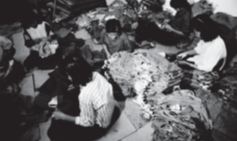A shirt in the market - Worksheets
CBSE Work Sheet 01
A shirt in the market
- Weaver?s _____ are one way to reduce the dependence on the merchant and to earn a higher income for the weavers.
- Traders
- Partnership
- Cooperatives
- Company
It is one of the largest cloth market in the world.
Tamil Nadu
Delhi
Kolkata
Agra
See what is shown in the figure below

Weaven of cloth
Garment factory
Protest by women
Market place
- Which of the following is false regarding weavers cooperatives
- In a weaver?s cooperative, the weavers form a group and take up certain activities collectively.
- The cooperative also does the marketing.
- They procure yarn from the yarn dealer and distribute it among the weavers.
- Weaver?s cooperatives are one way to increase the dependence on the merchant and to earn a higher income for the weavers.
The bi-weekly market in Tamil Nadu is known as
Erode
Irode
Rerode
None of these
- Fill in the blanks:
People who toil hard do not make ________.
- Fill in the blanks:
________ purchase the yarn and give it to the weavers who supply them the cloth.
- State true or false:
Foreign chain store do not make huge profits.
Who are mostly employed in the Impex garment factory?
Why did Swapna take loan from the local trader?
How are small farmers in the grip of the local trader?
No person gains equally in the market. Why?
Write a note on garment exporting factory.
CBSE Work Sheet 01
A shirt in the market
Solution
- (c) Cooperatives Explanation:
Weavers are paid very little by the.merchant under the putting out system. Weaver’s cooperatives are one way to reduce the dependence on the merchant and to earn a higher income for the weavers.
- (a)
Tamil Nadu
Explanation:Tamil Nadu
- (b)
Garment factory
Explanation:In the given image Women workers sewing buttons in a garment factory is shown.
- (d) Weaver?s cooperatives are one way to increase the dependence on the merchant and to earn a higher income for the weavers. Explanation:
Weaver’s cooperatives are one way to reduce the dependence on the merchant and to earn a higher income for the weavers
- (a)
Erode
Explanation:Erode
Profits
Merchants
False
Women are mostly employed in the Impex garment factory.
- She took loan from the local traders to buy seeds, fertilizers and pesticides for the cultivation of cotton.
Small farmers can not do without the help of the local traders. They depend on them for various reasons:
- During cropping season they take loan from the local traders.
- Whenever, there is an illness in the family they go to the local trader for help.
- Farmers also face seasonal unemployment. There are times in the year when they have no work and hence no income. During this time their survival depends on borrowing money from him.
Due to these reasons small farmers easily come in the grip of the powerful local traders.
No person gains equally in the market. The foreign businessmen earned huge profits followed by garment exporter, merchant and traders. The small cotton farmer, weaver, and factory worker earned so little so that they can’t even fulfill their day-to-day requirements. Though democracy is all about getting a fair wage in the market, this is not the case in, reality it is important for families to earn enough so that they can think of themselves as equal to others.
The cloth is supplied to a garment exporting factory by the Erode merchant, which is used to make shirts. The shirts will then be exported to foreign buyers. Foreign buyers include the businessmen from the US and Europe. They run a chain of stores on their own terms. They demand low prices from the supplier, high standards of quality and timely delivery. No defects or delay is entertained by the buyers. Hence, the exporter puts all his efforts to fulfill the demands of foreign buyers.
The pressure from buyers results in the following:- Cutting costs by garment factories.
- Workers are forced to work maximum at the lowest possible wages.
- Maximisation of profit.
- Supply of garments to foreign buyers at a cheap price.
